International Energy Policy
VerifiedAdded on 2023/06/07
|15
|3341
|480
AI Summary
This policy briefing paper discusses the challenges and opportunities for New Zealand in transitioning to a low carbon emitting economy. It explores pathways to achieve zero-emission, with a focus on the electricity generation and distribution sector and the transport sector.
Contribute Materials
Your contribution can guide someone’s learning journey. Share your
documents today.
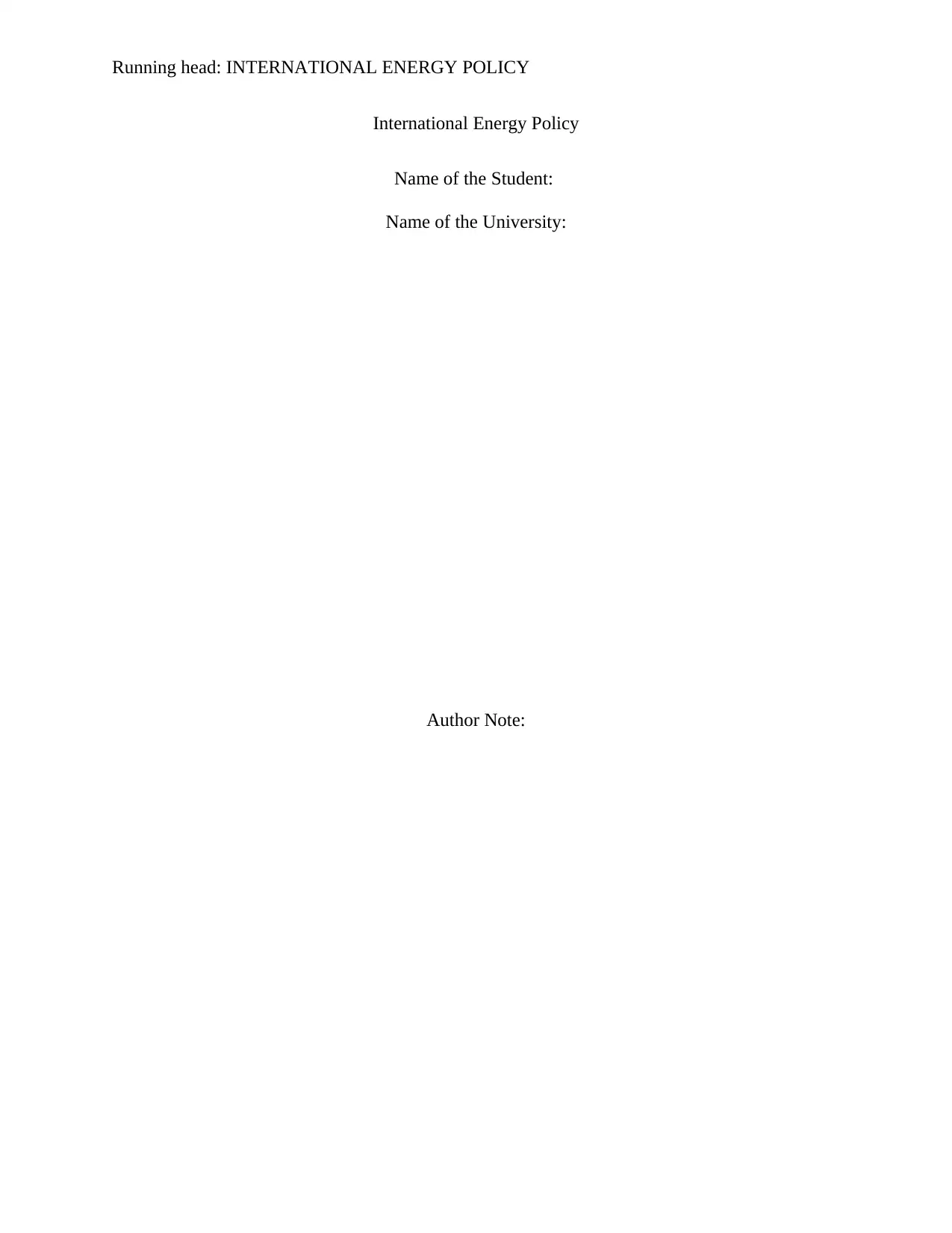
Running head: INTERNATIONAL ENERGY POLICY
International Energy Policy
Name of the Student:
Name of the University:
Author Note:
International Energy Policy
Name of the Student:
Name of the University:
Author Note:
Secure Best Marks with AI Grader
Need help grading? Try our AI Grader for instant feedback on your assignments.
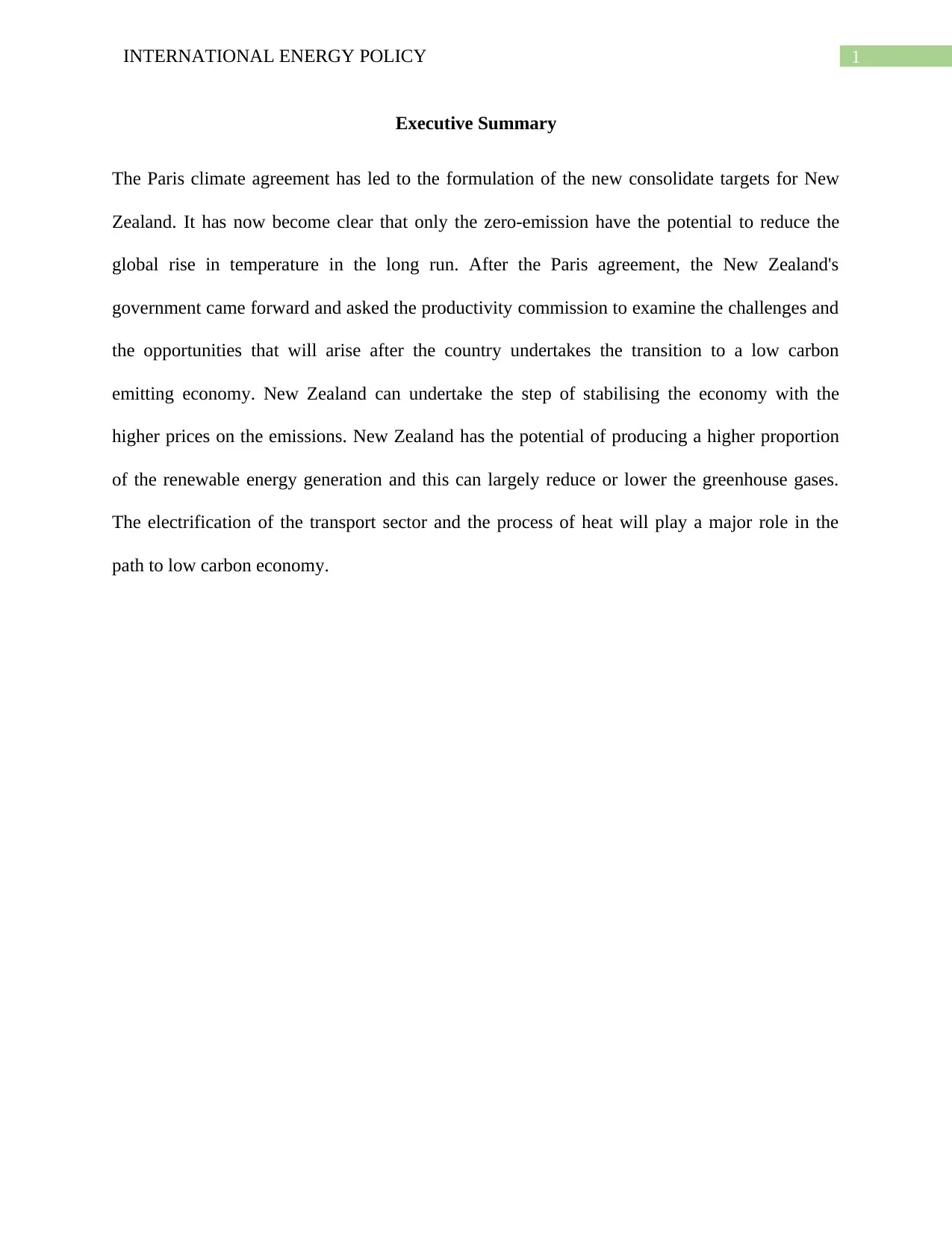
1INTERNATIONAL ENERGY POLICY
Executive Summary
The Paris climate agreement has led to the formulation of the new consolidate targets for New
Zealand. It has now become clear that only the zero-emission have the potential to reduce the
global rise in temperature in the long run. After the Paris agreement, the New Zealand's
government came forward and asked the productivity commission to examine the challenges and
the opportunities that will arise after the country undertakes the transition to a low carbon
emitting economy. New Zealand can undertake the step of stabilising the economy with the
higher prices on the emissions. New Zealand has the potential of producing a higher proportion
of the renewable energy generation and this can largely reduce or lower the greenhouse gases.
The electrification of the transport sector and the process of heat will play a major role in the
path to low carbon economy.
Executive Summary
The Paris climate agreement has led to the formulation of the new consolidate targets for New
Zealand. It has now become clear that only the zero-emission have the potential to reduce the
global rise in temperature in the long run. After the Paris agreement, the New Zealand's
government came forward and asked the productivity commission to examine the challenges and
the opportunities that will arise after the country undertakes the transition to a low carbon
emitting economy. New Zealand can undertake the step of stabilising the economy with the
higher prices on the emissions. New Zealand has the potential of producing a higher proportion
of the renewable energy generation and this can largely reduce or lower the greenhouse gases.
The electrification of the transport sector and the process of heat will play a major role in the
path to low carbon economy.
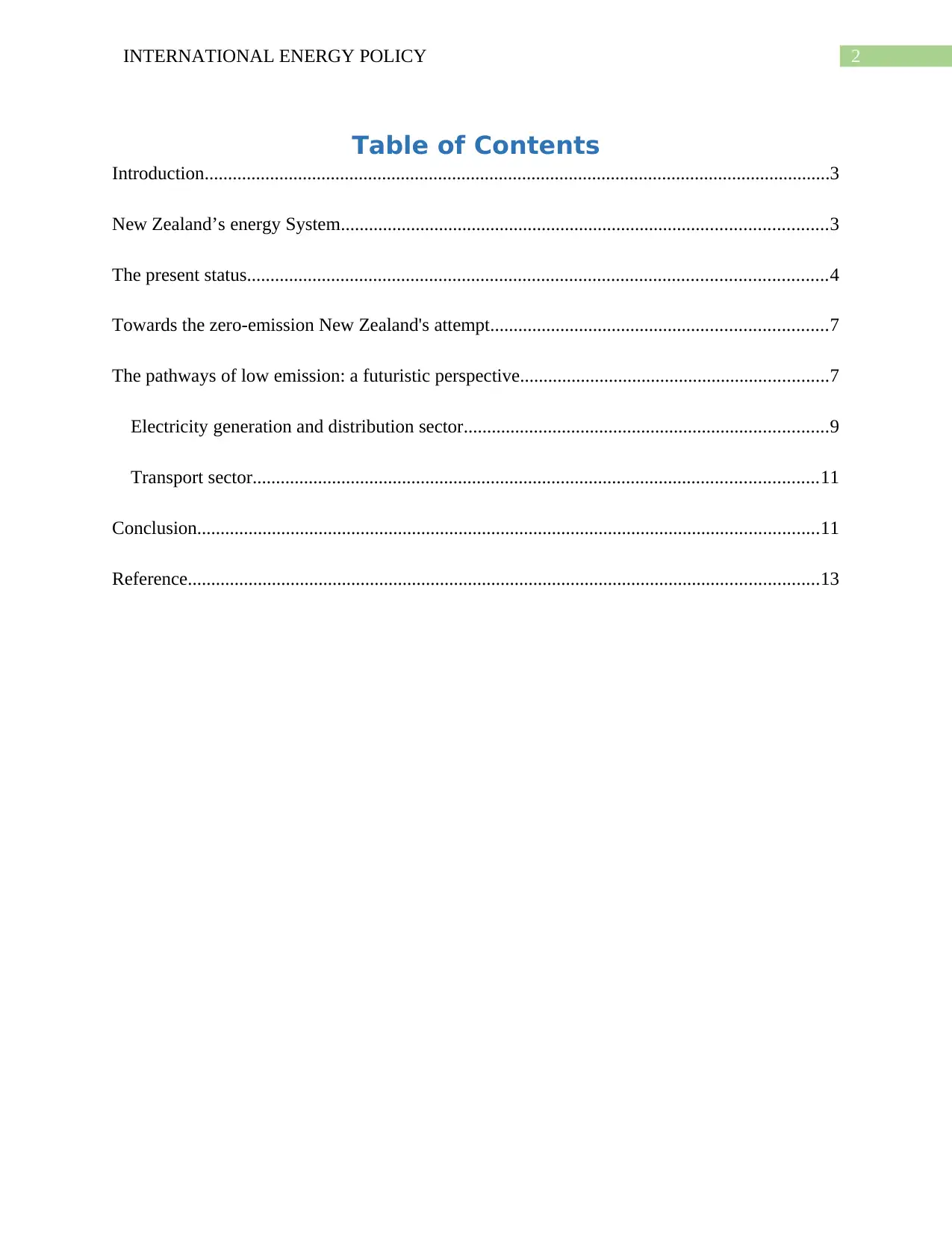
2INTERNATIONAL ENERGY POLICY
Table of Contents
Introduction......................................................................................................................................3
New Zealand’s energy System........................................................................................................3
The present status............................................................................................................................4
Towards the zero-emission New Zealand's attempt........................................................................7
The pathways of low emission: a futuristic perspective..................................................................7
Electricity generation and distribution sector..............................................................................9
Transport sector.........................................................................................................................11
Conclusion.....................................................................................................................................11
Reference.......................................................................................................................................13
Table of Contents
Introduction......................................................................................................................................3
New Zealand’s energy System........................................................................................................3
The present status............................................................................................................................4
Towards the zero-emission New Zealand's attempt........................................................................7
The pathways of low emission: a futuristic perspective..................................................................7
Electricity generation and distribution sector..............................................................................9
Transport sector.........................................................................................................................11
Conclusion.....................................................................................................................................11
Reference.......................................................................................................................................13
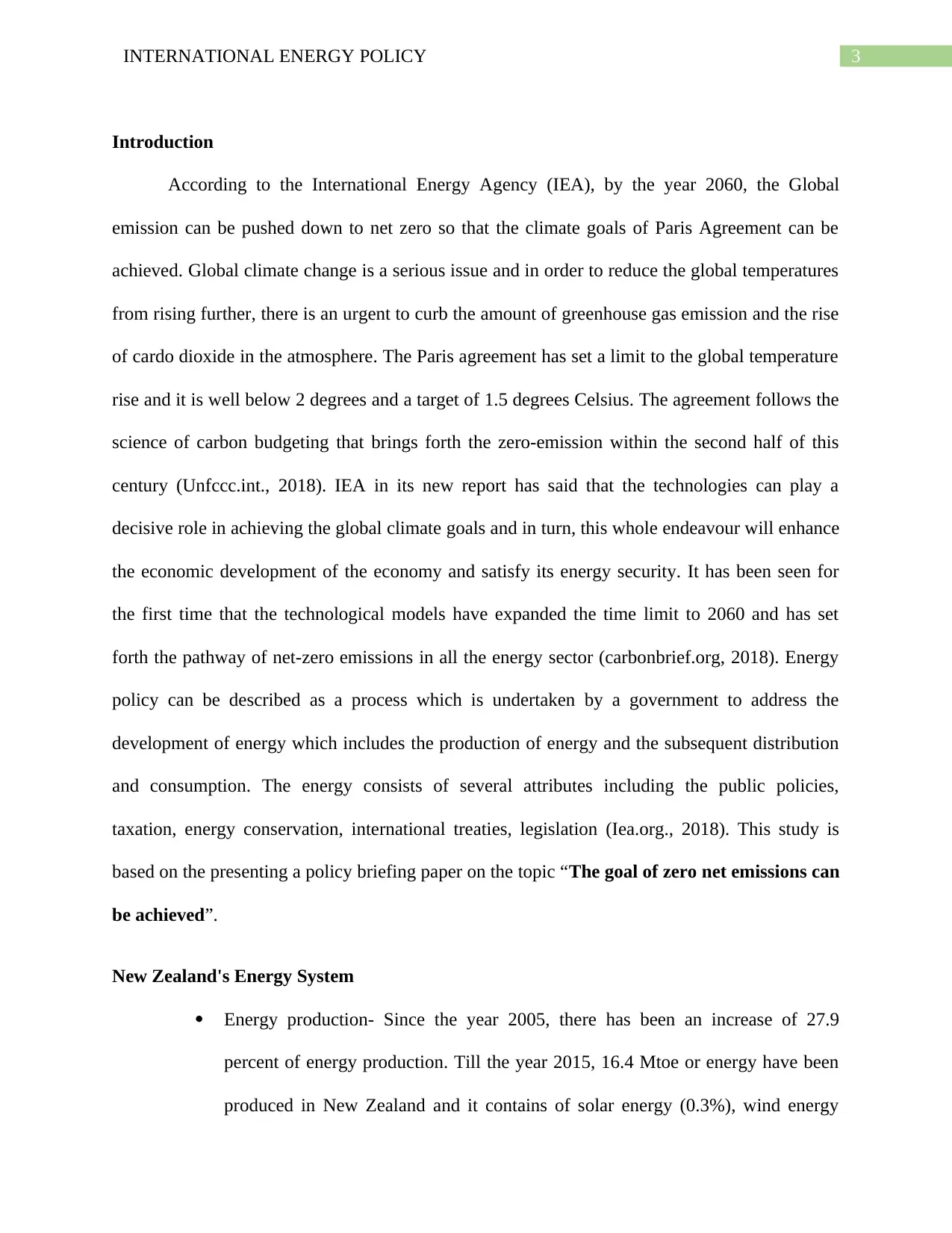
3INTERNATIONAL ENERGY POLICY
Introduction
According to the International Energy Agency (IEA), by the year 2060, the Global
emission can be pushed down to net zero so that the climate goals of Paris Agreement can be
achieved. Global climate change is a serious issue and in order to reduce the global temperatures
from rising further, there is an urgent to curb the amount of greenhouse gas emission and the rise
of cardo dioxide in the atmosphere. The Paris agreement has set a limit to the global temperature
rise and it is well below 2 degrees and a target of 1.5 degrees Celsius. The agreement follows the
science of carbon budgeting that brings forth the zero-emission within the second half of this
century (Unfccc.int., 2018). IEA in its new report has said that the technologies can play a
decisive role in achieving the global climate goals and in turn, this whole endeavour will enhance
the economic development of the economy and satisfy its energy security. It has been seen for
the first time that the technological models have expanded the time limit to 2060 and has set
forth the pathway of net-zero emissions in all the energy sector (carbonbrief.org, 2018). Energy
policy can be described as a process which is undertaken by a government to address the
development of energy which includes the production of energy and the subsequent distribution
and consumption. The energy consists of several attributes including the public policies,
taxation, energy conservation, international treaties, legislation (Iea.org., 2018). This study is
based on the presenting a policy briefing paper on the topic “The goal of zero net emissions can
be achieved”.
New Zealand's Energy System
Energy production- Since the year 2005, there has been an increase of 27.9
percent of energy production. Till the year 2015, 16.4 Mtoe or energy have been
produced in New Zealand and it contains of solar energy (0.3%), wind energy
Introduction
According to the International Energy Agency (IEA), by the year 2060, the Global
emission can be pushed down to net zero so that the climate goals of Paris Agreement can be
achieved. Global climate change is a serious issue and in order to reduce the global temperatures
from rising further, there is an urgent to curb the amount of greenhouse gas emission and the rise
of cardo dioxide in the atmosphere. The Paris agreement has set a limit to the global temperature
rise and it is well below 2 degrees and a target of 1.5 degrees Celsius. The agreement follows the
science of carbon budgeting that brings forth the zero-emission within the second half of this
century (Unfccc.int., 2018). IEA in its new report has said that the technologies can play a
decisive role in achieving the global climate goals and in turn, this whole endeavour will enhance
the economic development of the economy and satisfy its energy security. It has been seen for
the first time that the technological models have expanded the time limit to 2060 and has set
forth the pathway of net-zero emissions in all the energy sector (carbonbrief.org, 2018). Energy
policy can be described as a process which is undertaken by a government to address the
development of energy which includes the production of energy and the subsequent distribution
and consumption. The energy consists of several attributes including the public policies,
taxation, energy conservation, international treaties, legislation (Iea.org., 2018). This study is
based on the presenting a policy briefing paper on the topic “The goal of zero net emissions can
be achieved”.
New Zealand's Energy System
Energy production- Since the year 2005, there has been an increase of 27.9
percent of energy production. Till the year 2015, 16.4 Mtoe or energy have been
produced in New Zealand and it contains of solar energy (0.3%), wind energy
Secure Best Marks with AI Grader
Need help grading? Try our AI Grader for instant feedback on your assignments.
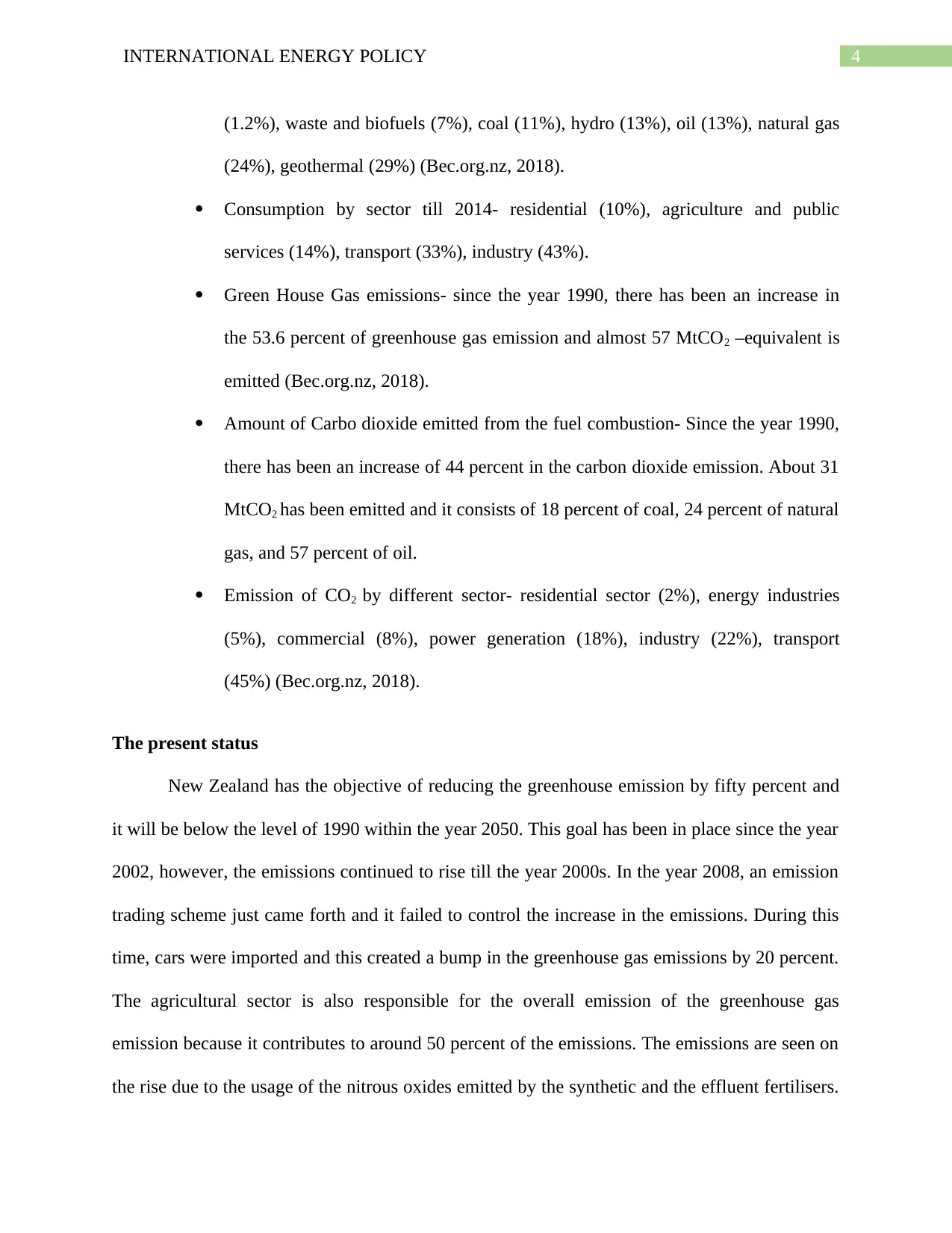
4INTERNATIONAL ENERGY POLICY
(1.2%), waste and biofuels (7%), coal (11%), hydro (13%), oil (13%), natural gas
(24%), geothermal (29%) (Bec.org.nz, 2018).
Consumption by sector till 2014- residential (10%), agriculture and public
services (14%), transport (33%), industry (43%).
Green House Gas emissions- since the year 1990, there has been an increase in
the 53.6 percent of greenhouse gas emission and almost 57 MtCO2 –equivalent is
emitted (Bec.org.nz, 2018).
Amount of Carbo dioxide emitted from the fuel combustion- Since the year 1990,
there has been an increase of 44 percent in the carbon dioxide emission. About 31
MtCO2 has been emitted and it consists of 18 percent of coal, 24 percent of natural
gas, and 57 percent of oil.
Emission of CO2 by different sector- residential sector (2%), energy industries
(5%), commercial (8%), power generation (18%), industry (22%), transport
(45%) (Bec.org.nz, 2018).
The present status
New Zealand has the objective of reducing the greenhouse emission by fifty percent and
it will be below the level of 1990 within the year 2050. This goal has been in place since the year
2002, however, the emissions continued to rise till the year 2000s. In the year 2008, an emission
trading scheme just came forth and it failed to control the increase in the emissions. During this
time, cars were imported and this created a bump in the greenhouse gas emissions by 20 percent.
The agricultural sector is also responsible for the overall emission of the greenhouse gas
emission because it contributes to around 50 percent of the emissions. The emissions are seen on
the rise due to the usage of the nitrous oxides emitted by the synthetic and the effluent fertilisers.
(1.2%), waste and biofuels (7%), coal (11%), hydro (13%), oil (13%), natural gas
(24%), geothermal (29%) (Bec.org.nz, 2018).
Consumption by sector till 2014- residential (10%), agriculture and public
services (14%), transport (33%), industry (43%).
Green House Gas emissions- since the year 1990, there has been an increase in
the 53.6 percent of greenhouse gas emission and almost 57 MtCO2 –equivalent is
emitted (Bec.org.nz, 2018).
Amount of Carbo dioxide emitted from the fuel combustion- Since the year 1990,
there has been an increase of 44 percent in the carbon dioxide emission. About 31
MtCO2 has been emitted and it consists of 18 percent of coal, 24 percent of natural
gas, and 57 percent of oil.
Emission of CO2 by different sector- residential sector (2%), energy industries
(5%), commercial (8%), power generation (18%), industry (22%), transport
(45%) (Bec.org.nz, 2018).
The present status
New Zealand has the objective of reducing the greenhouse emission by fifty percent and
it will be below the level of 1990 within the year 2050. This goal has been in place since the year
2002, however, the emissions continued to rise till the year 2000s. In the year 2008, an emission
trading scheme just came forth and it failed to control the increase in the emissions. During this
time, cars were imported and this created a bump in the greenhouse gas emissions by 20 percent.
The agricultural sector is also responsible for the overall emission of the greenhouse gas
emission because it contributes to around 50 percent of the emissions. The emissions are seen on
the rise due to the usage of the nitrous oxides emitted by the synthetic and the effluent fertilisers.
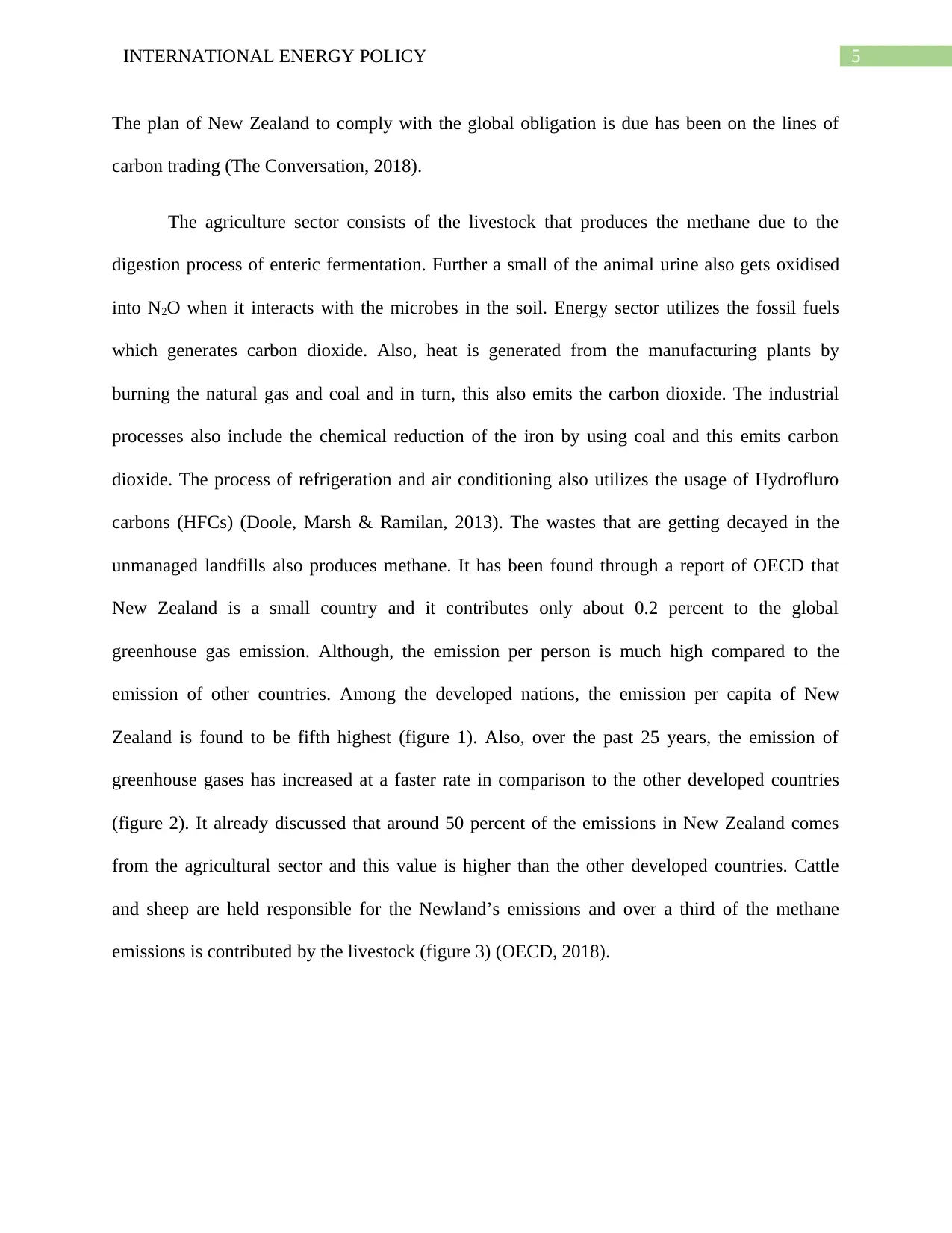
5INTERNATIONAL ENERGY POLICY
The plan of New Zealand to comply with the global obligation is due has been on the lines of
carbon trading (The Conversation, 2018).
The agriculture sector consists of the livestock that produces the methane due to the
digestion process of enteric fermentation. Further a small of the animal urine also gets oxidised
into N2O when it interacts with the microbes in the soil. Energy sector utilizes the fossil fuels
which generates carbon dioxide. Also, heat is generated from the manufacturing plants by
burning the natural gas and coal and in turn, this also emits the carbon dioxide. The industrial
processes also include the chemical reduction of the iron by using coal and this emits carbon
dioxide. The process of refrigeration and air conditioning also utilizes the usage of Hydrofluro
carbons (HFCs) (Doole, Marsh & Ramilan, 2013). The wastes that are getting decayed in the
unmanaged landfills also produces methane. It has been found through a report of OECD that
New Zealand is a small country and it contributes only about 0.2 percent to the global
greenhouse gas emission. Although, the emission per person is much high compared to the
emission of other countries. Among the developed nations, the emission per capita of New
Zealand is found to be fifth highest (figure 1). Also, over the past 25 years, the emission of
greenhouse gases has increased at a faster rate in comparison to the other developed countries
(figure 2). It already discussed that around 50 percent of the emissions in New Zealand comes
from the agricultural sector and this value is higher than the other developed countries. Cattle
and sheep are held responsible for the Newland’s emissions and over a third of the methane
emissions is contributed by the livestock (figure 3) (OECD, 2018).
The plan of New Zealand to comply with the global obligation is due has been on the lines of
carbon trading (The Conversation, 2018).
The agriculture sector consists of the livestock that produces the methane due to the
digestion process of enteric fermentation. Further a small of the animal urine also gets oxidised
into N2O when it interacts with the microbes in the soil. Energy sector utilizes the fossil fuels
which generates carbon dioxide. Also, heat is generated from the manufacturing plants by
burning the natural gas and coal and in turn, this also emits the carbon dioxide. The industrial
processes also include the chemical reduction of the iron by using coal and this emits carbon
dioxide. The process of refrigeration and air conditioning also utilizes the usage of Hydrofluro
carbons (HFCs) (Doole, Marsh & Ramilan, 2013). The wastes that are getting decayed in the
unmanaged landfills also produces methane. It has been found through a report of OECD that
New Zealand is a small country and it contributes only about 0.2 percent to the global
greenhouse gas emission. Although, the emission per person is much high compared to the
emission of other countries. Among the developed nations, the emission per capita of New
Zealand is found to be fifth highest (figure 1). Also, over the past 25 years, the emission of
greenhouse gases has increased at a faster rate in comparison to the other developed countries
(figure 2). It already discussed that around 50 percent of the emissions in New Zealand comes
from the agricultural sector and this value is higher than the other developed countries. Cattle
and sheep are held responsible for the Newland’s emissions and over a third of the methane
emissions is contributed by the livestock (figure 3) (OECD, 2018).
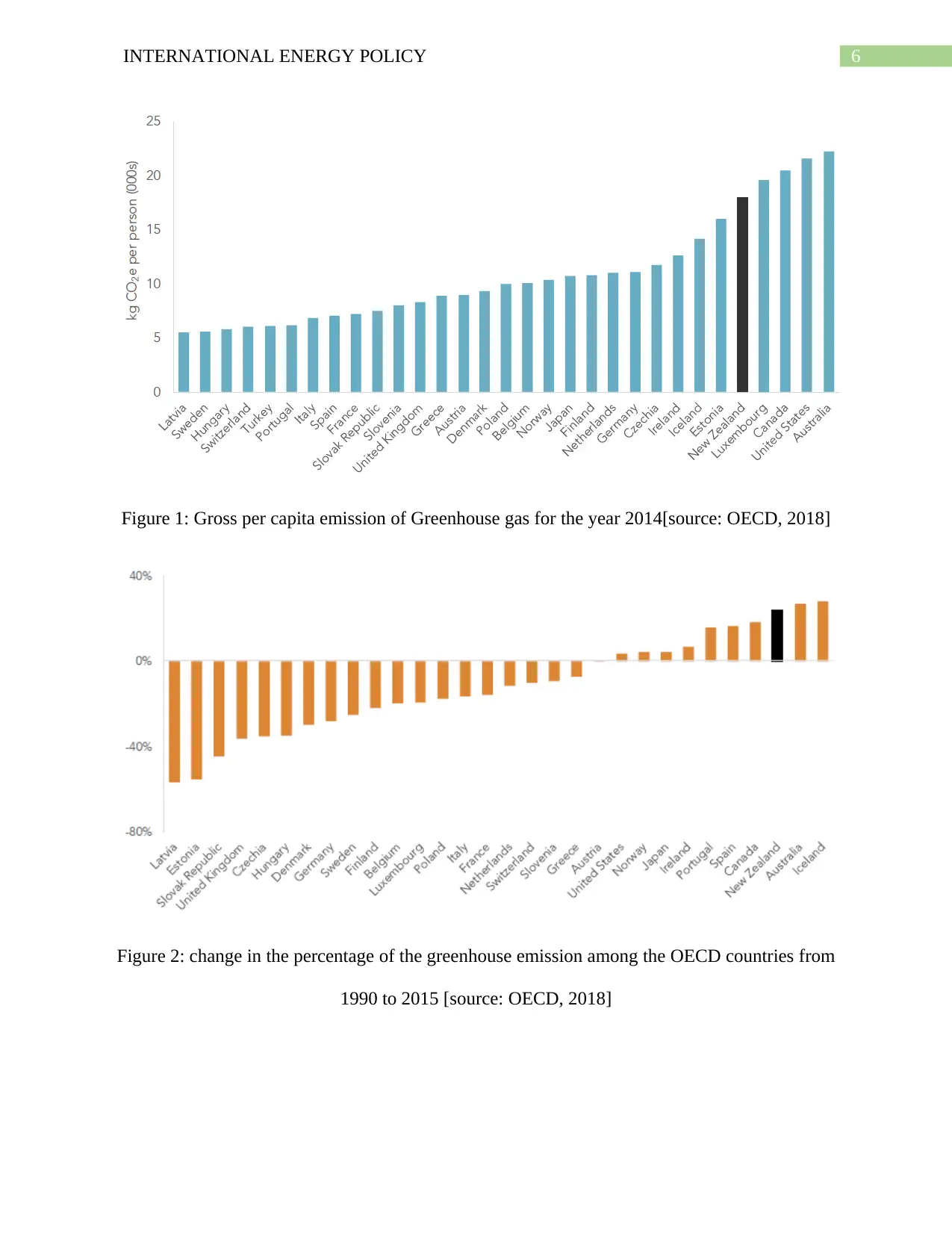
6INTERNATIONAL ENERGY POLICY
Figure 1: Gross per capita emission of Greenhouse gas for the year 2014[source: OECD, 2018]
Figure 2: change in the percentage of the greenhouse emission among the OECD countries from
1990 to 2015 [source: OECD, 2018]
Figure 1: Gross per capita emission of Greenhouse gas for the year 2014[source: OECD, 2018]
Figure 2: change in the percentage of the greenhouse emission among the OECD countries from
1990 to 2015 [source: OECD, 2018]
Paraphrase This Document
Need a fresh take? Get an instant paraphrase of this document with our AI Paraphraser
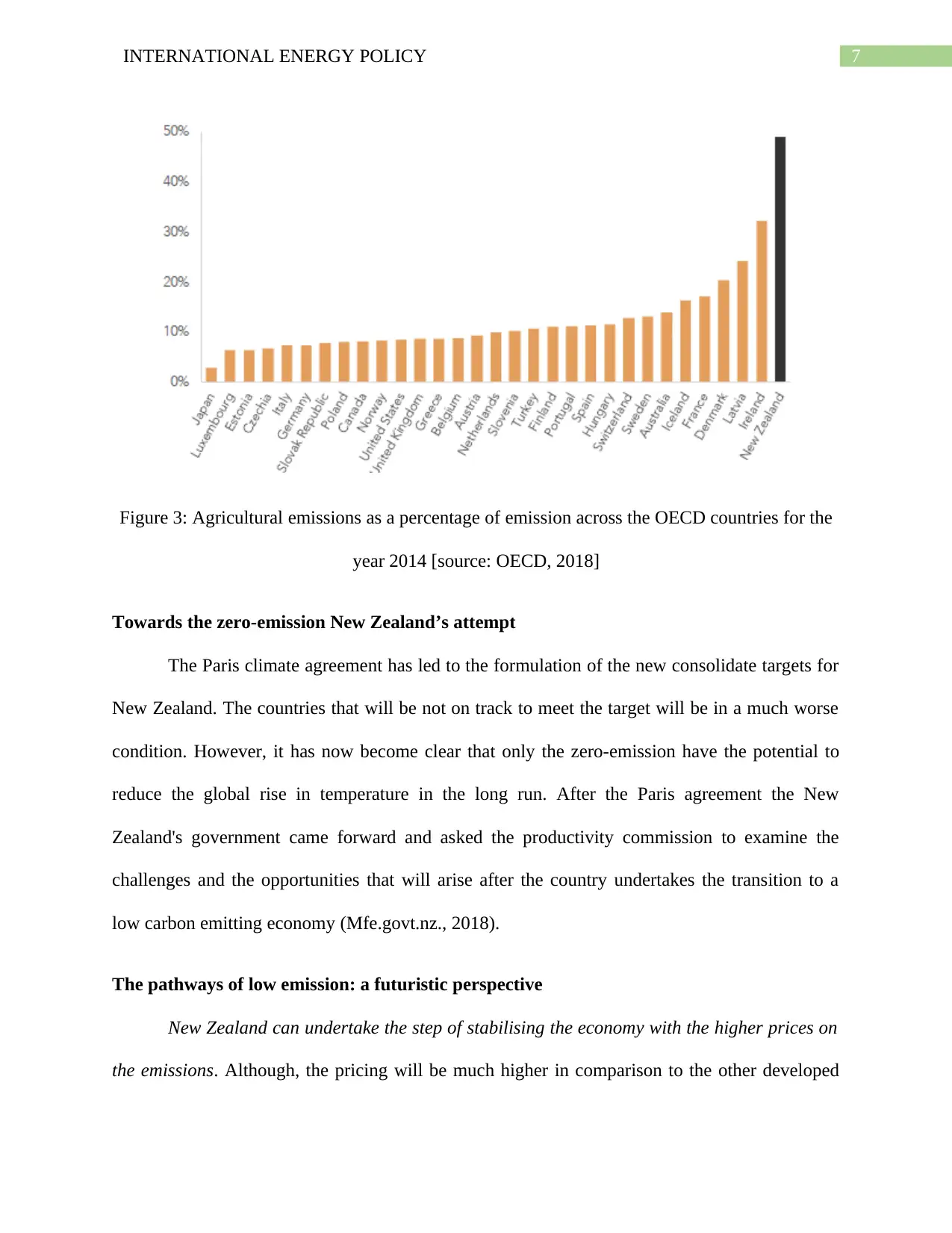
7INTERNATIONAL ENERGY POLICY
Figure 3: Agricultural emissions as a percentage of emission across the OECD countries for the
year 2014 [source: OECD, 2018]
Towards the zero-emission New Zealand’s attempt
The Paris climate agreement has led to the formulation of the new consolidate targets for
New Zealand. The countries that will be not on track to meet the target will be in a much worse
condition. However, it has now become clear that only the zero-emission have the potential to
reduce the global rise in temperature in the long run. After the Paris agreement the New
Zealand's government came forward and asked the productivity commission to examine the
challenges and the opportunities that will arise after the country undertakes the transition to a
low carbon emitting economy (Mfe.govt.nz., 2018).
The pathways of low emission: a futuristic perspective
New Zealand can undertake the step of stabilising the economy with the higher prices on
the emissions. Although, the pricing will be much higher in comparison to the other developed
Figure 3: Agricultural emissions as a percentage of emission across the OECD countries for the
year 2014 [source: OECD, 2018]
Towards the zero-emission New Zealand’s attempt
The Paris climate agreement has led to the formulation of the new consolidate targets for
New Zealand. The countries that will be not on track to meet the target will be in a much worse
condition. However, it has now become clear that only the zero-emission have the potential to
reduce the global rise in temperature in the long run. After the Paris agreement the New
Zealand's government came forward and asked the productivity commission to examine the
challenges and the opportunities that will arise after the country undertakes the transition to a
low carbon emitting economy (Mfe.govt.nz., 2018).
The pathways of low emission: a futuristic perspective
New Zealand can undertake the step of stabilising the economy with the higher prices on
the emissions. Although, the pricing will be much higher in comparison to the other developed
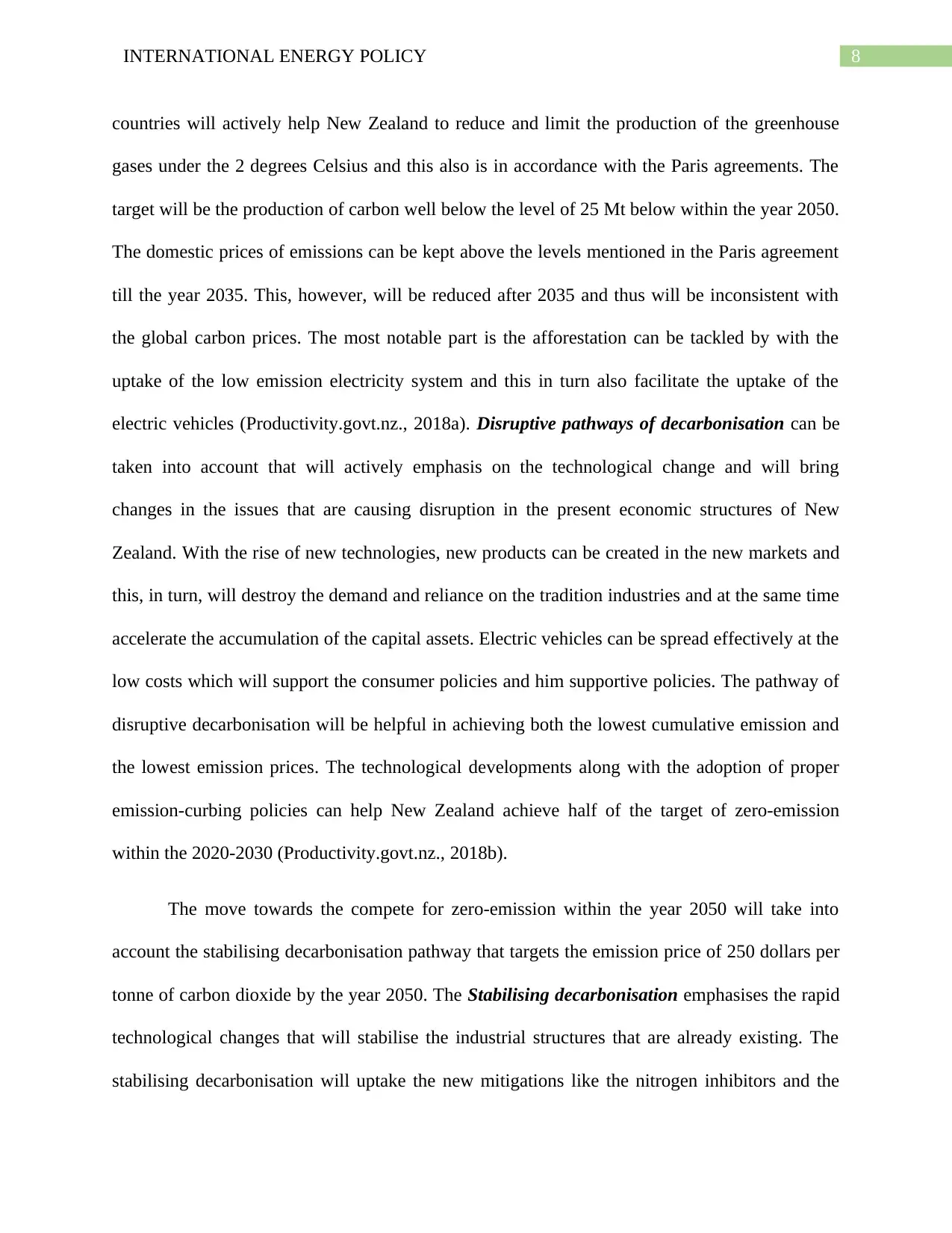
8INTERNATIONAL ENERGY POLICY
countries will actively help New Zealand to reduce and limit the production of the greenhouse
gases under the 2 degrees Celsius and this also is in accordance with the Paris agreements. The
target will be the production of carbon well below the level of 25 Mt below within the year 2050.
The domestic prices of emissions can be kept above the levels mentioned in the Paris agreement
till the year 2035. This, however, will be reduced after 2035 and thus will be inconsistent with
the global carbon prices. The most notable part is the afforestation can be tackled by with the
uptake of the low emission electricity system and this in turn also facilitate the uptake of the
electric vehicles (Productivity.govt.nz., 2018a). Disruptive pathways of decarbonisation can be
taken into account that will actively emphasis on the technological change and will bring
changes in the issues that are causing disruption in the present economic structures of New
Zealand. With the rise of new technologies, new products can be created in the new markets and
this, in turn, will destroy the demand and reliance on the tradition industries and at the same time
accelerate the accumulation of the capital assets. Electric vehicles can be spread effectively at the
low costs which will support the consumer policies and him supportive policies. The pathway of
disruptive decarbonisation will be helpful in achieving both the lowest cumulative emission and
the lowest emission prices. The technological developments along with the adoption of proper
emission-curbing policies can help New Zealand achieve half of the target of zero-emission
within the 2020-2030 (Productivity.govt.nz., 2018b).
The move towards the compete for zero-emission within the year 2050 will take into
account the stabilising decarbonisation pathway that targets the emission price of 250 dollars per
tonne of carbon dioxide by the year 2050. The Stabilising decarbonisation emphasises the rapid
technological changes that will stabilise the industrial structures that are already existing. The
stabilising decarbonisation will uptake the new mitigations like the nitrogen inhibitors and the
countries will actively help New Zealand to reduce and limit the production of the greenhouse
gases under the 2 degrees Celsius and this also is in accordance with the Paris agreements. The
target will be the production of carbon well below the level of 25 Mt below within the year 2050.
The domestic prices of emissions can be kept above the levels mentioned in the Paris agreement
till the year 2035. This, however, will be reduced after 2035 and thus will be inconsistent with
the global carbon prices. The most notable part is the afforestation can be tackled by with the
uptake of the low emission electricity system and this in turn also facilitate the uptake of the
electric vehicles (Productivity.govt.nz., 2018a). Disruptive pathways of decarbonisation can be
taken into account that will actively emphasis on the technological change and will bring
changes in the issues that are causing disruption in the present economic structures of New
Zealand. With the rise of new technologies, new products can be created in the new markets and
this, in turn, will destroy the demand and reliance on the tradition industries and at the same time
accelerate the accumulation of the capital assets. Electric vehicles can be spread effectively at the
low costs which will support the consumer policies and him supportive policies. The pathway of
disruptive decarbonisation will be helpful in achieving both the lowest cumulative emission and
the lowest emission prices. The technological developments along with the adoption of proper
emission-curbing policies can help New Zealand achieve half of the target of zero-emission
within the 2020-2030 (Productivity.govt.nz., 2018b).
The move towards the compete for zero-emission within the year 2050 will take into
account the stabilising decarbonisation pathway that targets the emission price of 250 dollars per
tonne of carbon dioxide by the year 2050. The Stabilising decarbonisation emphasises the rapid
technological changes that will stabilise the industrial structures that are already existing. The
stabilising decarbonisation will uptake the new mitigations like the nitrogen inhibitors and the
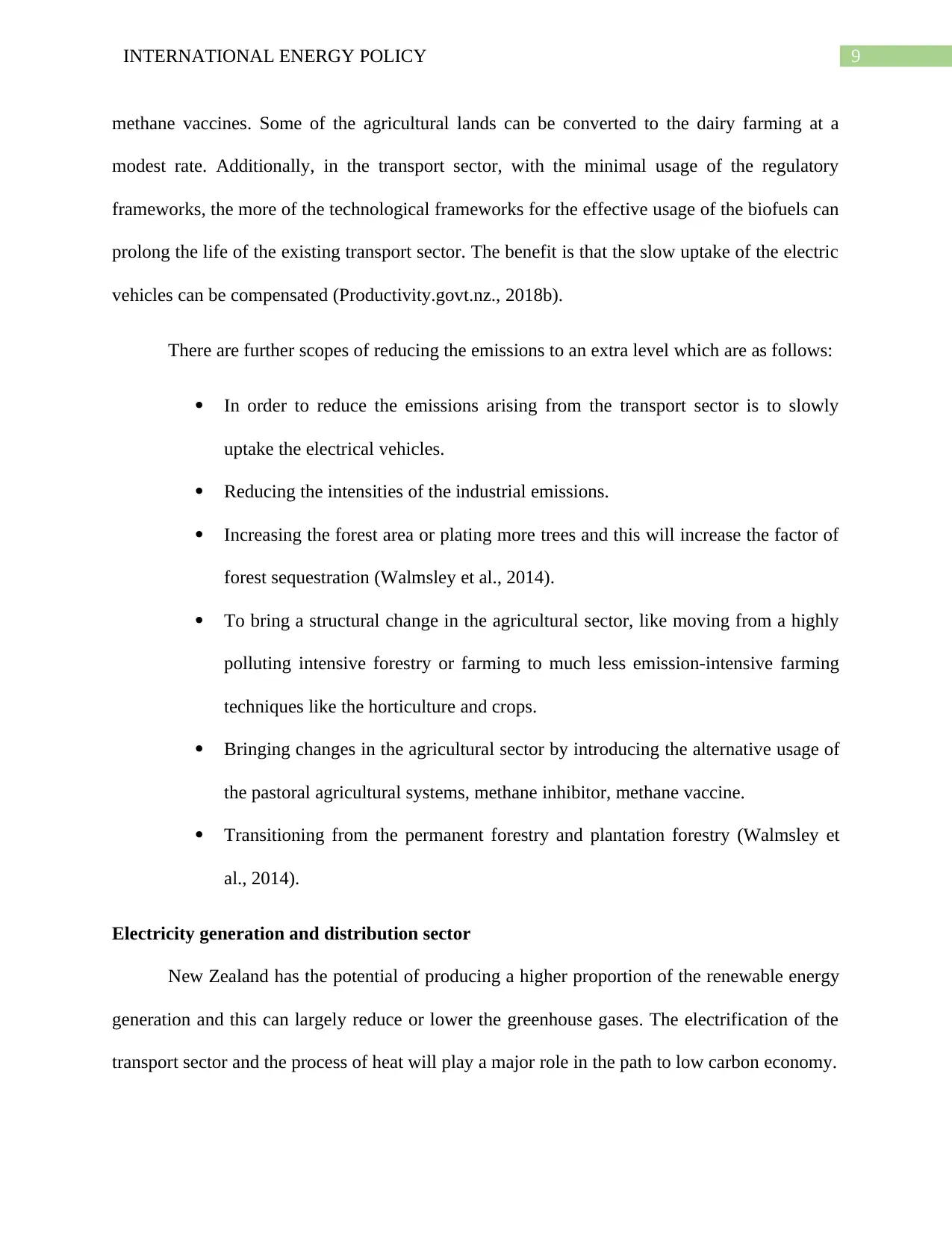
9INTERNATIONAL ENERGY POLICY
methane vaccines. Some of the agricultural lands can be converted to the dairy farming at a
modest rate. Additionally, in the transport sector, with the minimal usage of the regulatory
frameworks, the more of the technological frameworks for the effective usage of the biofuels can
prolong the life of the existing transport sector. The benefit is that the slow uptake of the electric
vehicles can be compensated (Productivity.govt.nz., 2018b).
There are further scopes of reducing the emissions to an extra level which are as follows:
In order to reduce the emissions arising from the transport sector is to slowly
uptake the electrical vehicles.
Reducing the intensities of the industrial emissions.
Increasing the forest area or plating more trees and this will increase the factor of
forest sequestration (Walmsley et al., 2014).
To bring a structural change in the agricultural sector, like moving from a highly
polluting intensive forestry or farming to much less emission-intensive farming
techniques like the horticulture and crops.
Bringing changes in the agricultural sector by introducing the alternative usage of
the pastoral agricultural systems, methane inhibitor, methane vaccine.
Transitioning from the permanent forestry and plantation forestry (Walmsley et
al., 2014).
Electricity generation and distribution sector
New Zealand has the potential of producing a higher proportion of the renewable energy
generation and this can largely reduce or lower the greenhouse gases. The electrification of the
transport sector and the process of heat will play a major role in the path to low carbon economy.
methane vaccines. Some of the agricultural lands can be converted to the dairy farming at a
modest rate. Additionally, in the transport sector, with the minimal usage of the regulatory
frameworks, the more of the technological frameworks for the effective usage of the biofuels can
prolong the life of the existing transport sector. The benefit is that the slow uptake of the electric
vehicles can be compensated (Productivity.govt.nz., 2018b).
There are further scopes of reducing the emissions to an extra level which are as follows:
In order to reduce the emissions arising from the transport sector is to slowly
uptake the electrical vehicles.
Reducing the intensities of the industrial emissions.
Increasing the forest area or plating more trees and this will increase the factor of
forest sequestration (Walmsley et al., 2014).
To bring a structural change in the agricultural sector, like moving from a highly
polluting intensive forestry or farming to much less emission-intensive farming
techniques like the horticulture and crops.
Bringing changes in the agricultural sector by introducing the alternative usage of
the pastoral agricultural systems, methane inhibitor, methane vaccine.
Transitioning from the permanent forestry and plantation forestry (Walmsley et
al., 2014).
Electricity generation and distribution sector
New Zealand has the potential of producing a higher proportion of the renewable energy
generation and this can largely reduce or lower the greenhouse gases. The electrification of the
transport sector and the process of heat will play a major role in the path to low carbon economy.
Secure Best Marks with AI Grader
Need help grading? Try our AI Grader for instant feedback on your assignments.
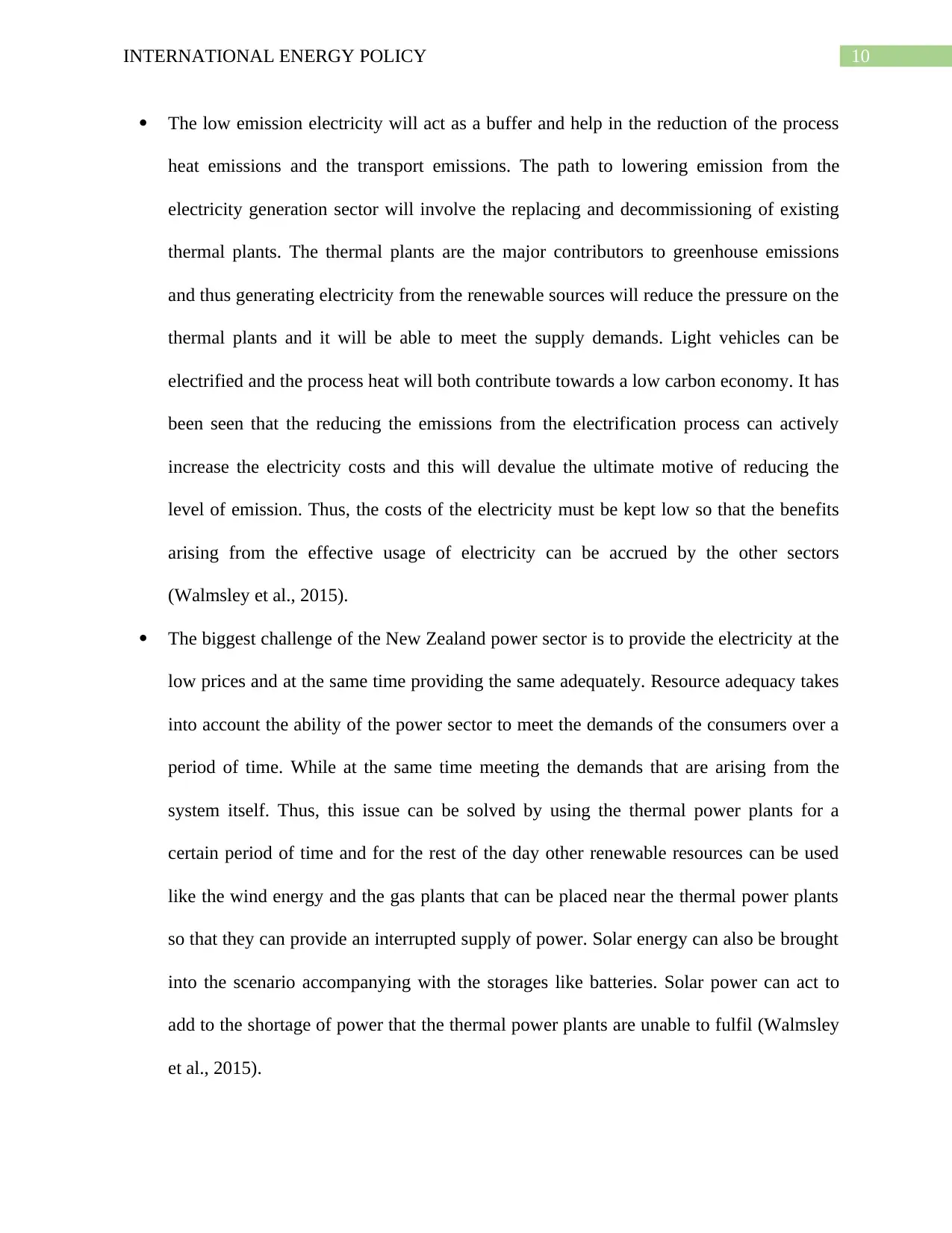
10INTERNATIONAL ENERGY POLICY
The low emission electricity will act as a buffer and help in the reduction of the process
heat emissions and the transport emissions. The path to lowering emission from the
electricity generation sector will involve the replacing and decommissioning of existing
thermal plants. The thermal plants are the major contributors to greenhouse emissions
and thus generating electricity from the renewable sources will reduce the pressure on the
thermal plants and it will be able to meet the supply demands. Light vehicles can be
electrified and the process heat will both contribute towards a low carbon economy. It has
been seen that the reducing the emissions from the electrification process can actively
increase the electricity costs and this will devalue the ultimate motive of reducing the
level of emission. Thus, the costs of the electricity must be kept low so that the benefits
arising from the effective usage of electricity can be accrued by the other sectors
(Walmsley et al., 2015).
The biggest challenge of the New Zealand power sector is to provide the electricity at the
low prices and at the same time providing the same adequately. Resource adequacy takes
into account the ability of the power sector to meet the demands of the consumers over a
period of time. While at the same time meeting the demands that are arising from the
system itself. Thus, this issue can be solved by using the thermal power plants for a
certain period of time and for the rest of the day other renewable resources can be used
like the wind energy and the gas plants that can be placed near the thermal power plants
so that they can provide an interrupted supply of power. Solar energy can also be brought
into the scenario accompanying with the storages like batteries. Solar power can act to
add to the shortage of power that the thermal power plants are unable to fulfil (Walmsley
et al., 2015).
The low emission electricity will act as a buffer and help in the reduction of the process
heat emissions and the transport emissions. The path to lowering emission from the
electricity generation sector will involve the replacing and decommissioning of existing
thermal plants. The thermal plants are the major contributors to greenhouse emissions
and thus generating electricity from the renewable sources will reduce the pressure on the
thermal plants and it will be able to meet the supply demands. Light vehicles can be
electrified and the process heat will both contribute towards a low carbon economy. It has
been seen that the reducing the emissions from the electrification process can actively
increase the electricity costs and this will devalue the ultimate motive of reducing the
level of emission. Thus, the costs of the electricity must be kept low so that the benefits
arising from the effective usage of electricity can be accrued by the other sectors
(Walmsley et al., 2015).
The biggest challenge of the New Zealand power sector is to provide the electricity at the
low prices and at the same time providing the same adequately. Resource adequacy takes
into account the ability of the power sector to meet the demands of the consumers over a
period of time. While at the same time meeting the demands that are arising from the
system itself. Thus, this issue can be solved by using the thermal power plants for a
certain period of time and for the rest of the day other renewable resources can be used
like the wind energy and the gas plants that can be placed near the thermal power plants
so that they can provide an interrupted supply of power. Solar energy can also be brought
into the scenario accompanying with the storages like batteries. Solar power can act to
add to the shortage of power that the thermal power plants are unable to fulfil (Walmsley
et al., 2015).
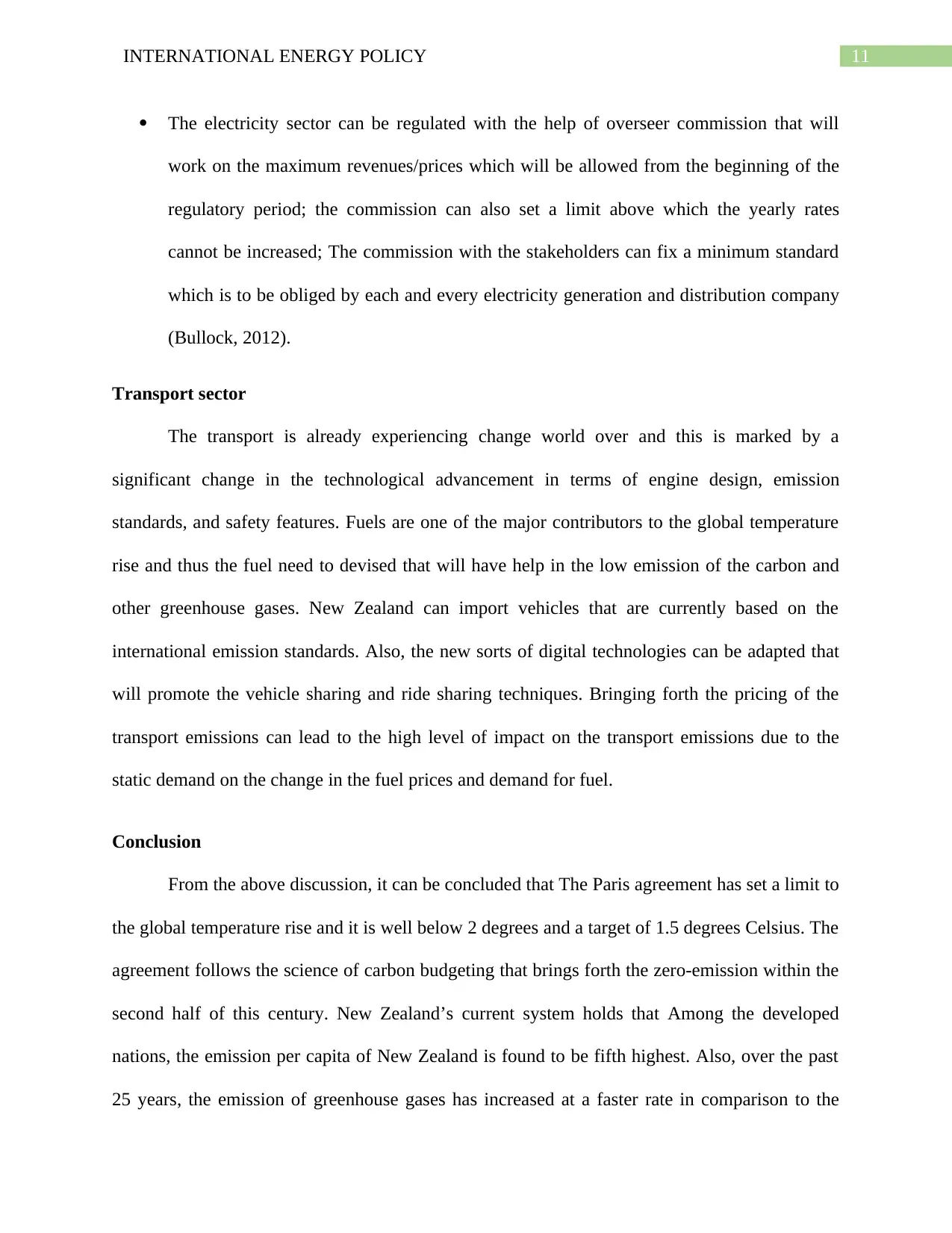
11INTERNATIONAL ENERGY POLICY
The electricity sector can be regulated with the help of overseer commission that will
work on the maximum revenues/prices which will be allowed from the beginning of the
regulatory period; the commission can also set a limit above which the yearly rates
cannot be increased; The commission with the stakeholders can fix a minimum standard
which is to be obliged by each and every electricity generation and distribution company
(Bullock, 2012).
Transport sector
The transport is already experiencing change world over and this is marked by a
significant change in the technological advancement in terms of engine design, emission
standards, and safety features. Fuels are one of the major contributors to the global temperature
rise and thus the fuel need to devised that will have help in the low emission of the carbon and
other greenhouse gases. New Zealand can import vehicles that are currently based on the
international emission standards. Also, the new sorts of digital technologies can be adapted that
will promote the vehicle sharing and ride sharing techniques. Bringing forth the pricing of the
transport emissions can lead to the high level of impact on the transport emissions due to the
static demand on the change in the fuel prices and demand for fuel.
Conclusion
From the above discussion, it can be concluded that The Paris agreement has set a limit to
the global temperature rise and it is well below 2 degrees and a target of 1.5 degrees Celsius. The
agreement follows the science of carbon budgeting that brings forth the zero-emission within the
second half of this century. New Zealand’s current system holds that Among the developed
nations, the emission per capita of New Zealand is found to be fifth highest. Also, over the past
25 years, the emission of greenhouse gases has increased at a faster rate in comparison to the
The electricity sector can be regulated with the help of overseer commission that will
work on the maximum revenues/prices which will be allowed from the beginning of the
regulatory period; the commission can also set a limit above which the yearly rates
cannot be increased; The commission with the stakeholders can fix a minimum standard
which is to be obliged by each and every electricity generation and distribution company
(Bullock, 2012).
Transport sector
The transport is already experiencing change world over and this is marked by a
significant change in the technological advancement in terms of engine design, emission
standards, and safety features. Fuels are one of the major contributors to the global temperature
rise and thus the fuel need to devised that will have help in the low emission of the carbon and
other greenhouse gases. New Zealand can import vehicles that are currently based on the
international emission standards. Also, the new sorts of digital technologies can be adapted that
will promote the vehicle sharing and ride sharing techniques. Bringing forth the pricing of the
transport emissions can lead to the high level of impact on the transport emissions due to the
static demand on the change in the fuel prices and demand for fuel.
Conclusion
From the above discussion, it can be concluded that The Paris agreement has set a limit to
the global temperature rise and it is well below 2 degrees and a target of 1.5 degrees Celsius. The
agreement follows the science of carbon budgeting that brings forth the zero-emission within the
second half of this century. New Zealand’s current system holds that Among the developed
nations, the emission per capita of New Zealand is found to be fifth highest. Also, over the past
25 years, the emission of greenhouse gases has increased at a faster rate in comparison to the

12INTERNATIONAL ENERGY POLICY
other developed countries. It already discussed that around 50 percent of the emissions in New
Zealand comes from the agricultural sector and this value is higher than the other developed
countries. Cattle and sheep are held responsible for the Newland’s emissions and over a third of
the methane emissions is contributed by the livestock.
other developed countries. It already discussed that around 50 percent of the emissions in New
Zealand comes from the agricultural sector and this value is higher than the other developed
countries. Cattle and sheep are held responsible for the Newland’s emissions and over a third of
the methane emissions is contributed by the livestock.
Paraphrase This Document
Need a fresh take? Get an instant paraphrase of this document with our AI Paraphraser
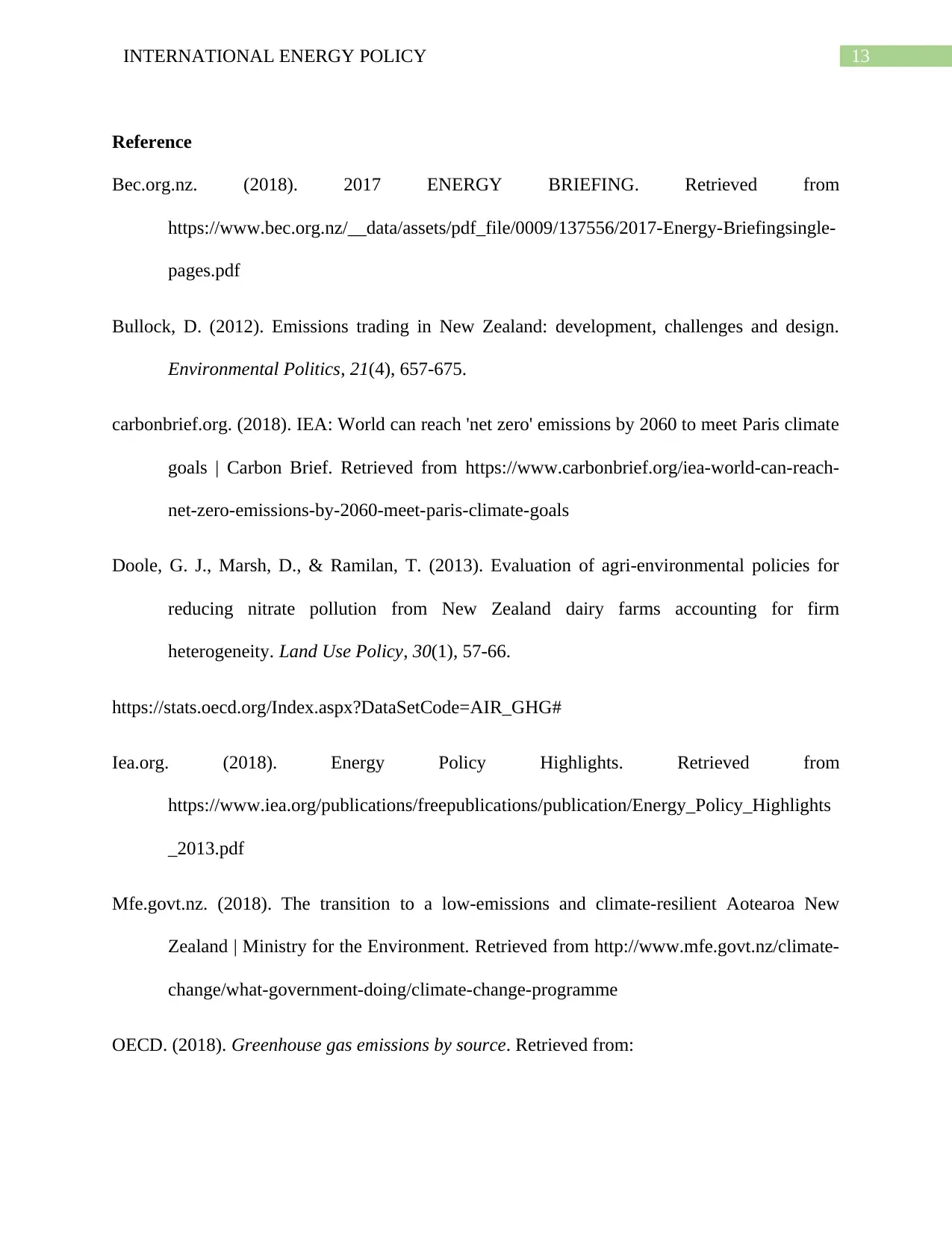
13INTERNATIONAL ENERGY POLICY
Reference
Bec.org.nz. (2018). 2017 ENERGY BRIEFING. Retrieved from
https://www.bec.org.nz/__data/assets/pdf_file/0009/137556/2017-Energy-Briefingsingle-
pages.pdf
Bullock, D. (2012). Emissions trading in New Zealand: development, challenges and design.
Environmental Politics, 21(4), 657-675.
carbonbrief.org. (2018). IEA: World can reach 'net zero' emissions by 2060 to meet Paris climate
goals | Carbon Brief. Retrieved from https://www.carbonbrief.org/iea-world-can-reach-
net-zero-emissions-by-2060-meet-paris-climate-goals
Doole, G. J., Marsh, D., & Ramilan, T. (2013). Evaluation of agri-environmental policies for
reducing nitrate pollution from New Zealand dairy farms accounting for firm
heterogeneity. Land Use Policy, 30(1), 57-66.
https://stats.oecd.org/Index.aspx?DataSetCode=AIR_GHG#
Iea.org. (2018). Energy Policy Highlights. Retrieved from
https://www.iea.org/publications/freepublications/publication/Energy_Policy_Highlights
_2013.pdf
Mfe.govt.nz. (2018). The transition to a low-emissions and climate-resilient Aotearoa New
Zealand | Ministry for the Environment. Retrieved from http://www.mfe.govt.nz/climate-
change/what-government-doing/climate-change-programme
OECD. (2018). Greenhouse gas emissions by source. Retrieved from:
Reference
Bec.org.nz. (2018). 2017 ENERGY BRIEFING. Retrieved from
https://www.bec.org.nz/__data/assets/pdf_file/0009/137556/2017-Energy-Briefingsingle-
pages.pdf
Bullock, D. (2012). Emissions trading in New Zealand: development, challenges and design.
Environmental Politics, 21(4), 657-675.
carbonbrief.org. (2018). IEA: World can reach 'net zero' emissions by 2060 to meet Paris climate
goals | Carbon Brief. Retrieved from https://www.carbonbrief.org/iea-world-can-reach-
net-zero-emissions-by-2060-meet-paris-climate-goals
Doole, G. J., Marsh, D., & Ramilan, T. (2013). Evaluation of agri-environmental policies for
reducing nitrate pollution from New Zealand dairy farms accounting for firm
heterogeneity. Land Use Policy, 30(1), 57-66.
https://stats.oecd.org/Index.aspx?DataSetCode=AIR_GHG#
Iea.org. (2018). Energy Policy Highlights. Retrieved from
https://www.iea.org/publications/freepublications/publication/Energy_Policy_Highlights
_2013.pdf
Mfe.govt.nz. (2018). The transition to a low-emissions and climate-resilient Aotearoa New
Zealand | Ministry for the Environment. Retrieved from http://www.mfe.govt.nz/climate-
change/what-government-doing/climate-change-programme
OECD. (2018). Greenhouse gas emissions by source. Retrieved from:
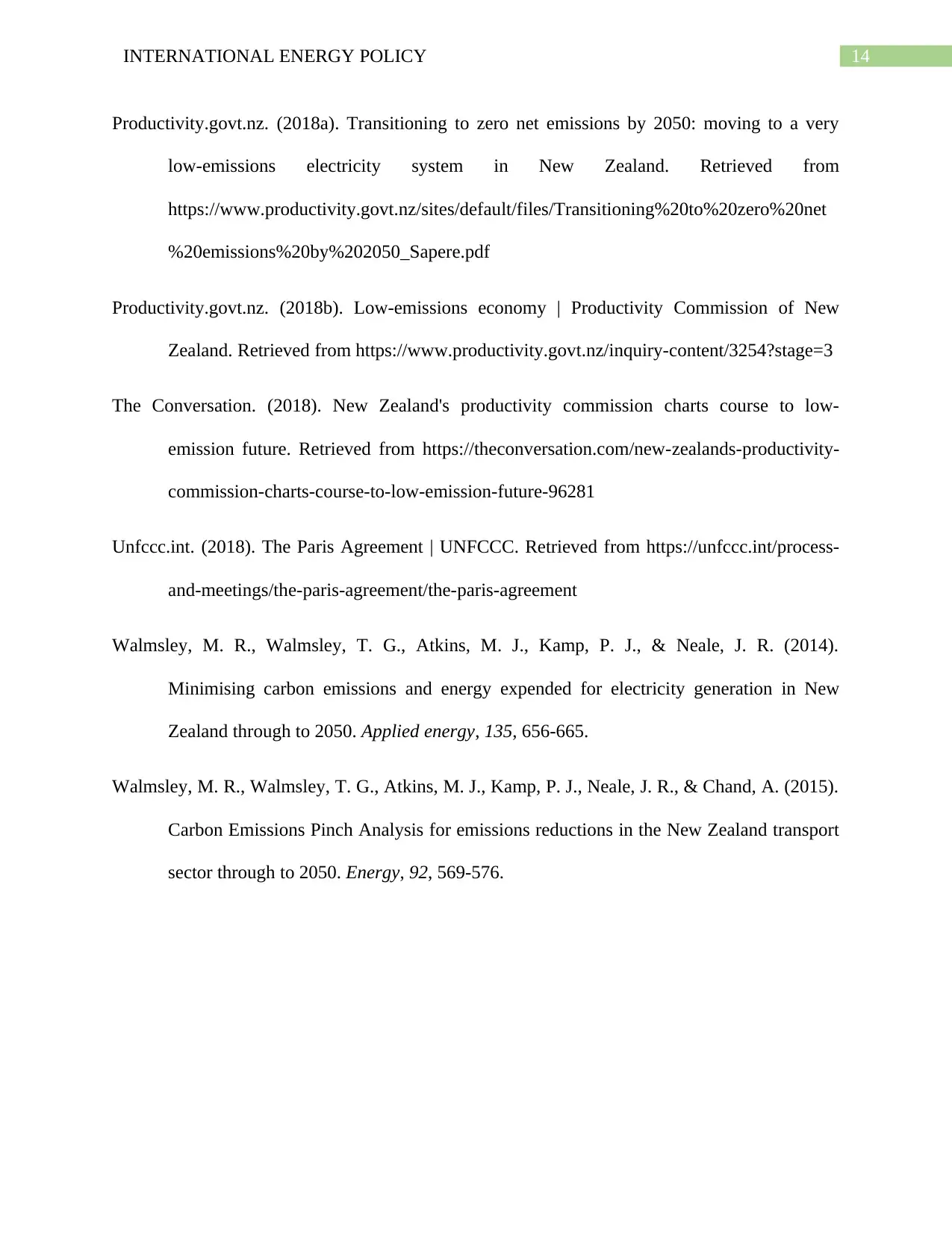
14INTERNATIONAL ENERGY POLICY
Productivity.govt.nz. (2018a). Transitioning to zero net emissions by 2050: moving to a very
low-emissions electricity system in New Zealand. Retrieved from
https://www.productivity.govt.nz/sites/default/files/Transitioning%20to%20zero%20net
%20emissions%20by%202050_Sapere.pdf
Productivity.govt.nz. (2018b). Low-emissions economy | Productivity Commission of New
Zealand. Retrieved from https://www.productivity.govt.nz/inquiry-content/3254?stage=3
The Conversation. (2018). New Zealand's productivity commission charts course to low-
emission future. Retrieved from https://theconversation.com/new-zealands-productivity-
commission-charts-course-to-low-emission-future-96281
Unfccc.int. (2018). The Paris Agreement | UNFCCC. Retrieved from https://unfccc.int/process-
and-meetings/the-paris-agreement/the-paris-agreement
Walmsley, M. R., Walmsley, T. G., Atkins, M. J., Kamp, P. J., & Neale, J. R. (2014).
Minimising carbon emissions and energy expended for electricity generation in New
Zealand through to 2050. Applied energy, 135, 656-665.
Walmsley, M. R., Walmsley, T. G., Atkins, M. J., Kamp, P. J., Neale, J. R., & Chand, A. (2015).
Carbon Emissions Pinch Analysis for emissions reductions in the New Zealand transport
sector through to 2050. Energy, 92, 569-576.
Productivity.govt.nz. (2018a). Transitioning to zero net emissions by 2050: moving to a very
low-emissions electricity system in New Zealand. Retrieved from
https://www.productivity.govt.nz/sites/default/files/Transitioning%20to%20zero%20net
%20emissions%20by%202050_Sapere.pdf
Productivity.govt.nz. (2018b). Low-emissions economy | Productivity Commission of New
Zealand. Retrieved from https://www.productivity.govt.nz/inquiry-content/3254?stage=3
The Conversation. (2018). New Zealand's productivity commission charts course to low-
emission future. Retrieved from https://theconversation.com/new-zealands-productivity-
commission-charts-course-to-low-emission-future-96281
Unfccc.int. (2018). The Paris Agreement | UNFCCC. Retrieved from https://unfccc.int/process-
and-meetings/the-paris-agreement/the-paris-agreement
Walmsley, M. R., Walmsley, T. G., Atkins, M. J., Kamp, P. J., & Neale, J. R. (2014).
Minimising carbon emissions and energy expended for electricity generation in New
Zealand through to 2050. Applied energy, 135, 656-665.
Walmsley, M. R., Walmsley, T. G., Atkins, M. J., Kamp, P. J., Neale, J. R., & Chand, A. (2015).
Carbon Emissions Pinch Analysis for emissions reductions in the New Zealand transport
sector through to 2050. Energy, 92, 569-576.
1 out of 15
Related Documents
Your All-in-One AI-Powered Toolkit for Academic Success.
+13062052269
info@desklib.com
Available 24*7 on WhatsApp / Email
![[object Object]](/_next/static/media/star-bottom.7253800d.svg)
Unlock your academic potential
© 2024 | Zucol Services PVT LTD | All rights reserved.





